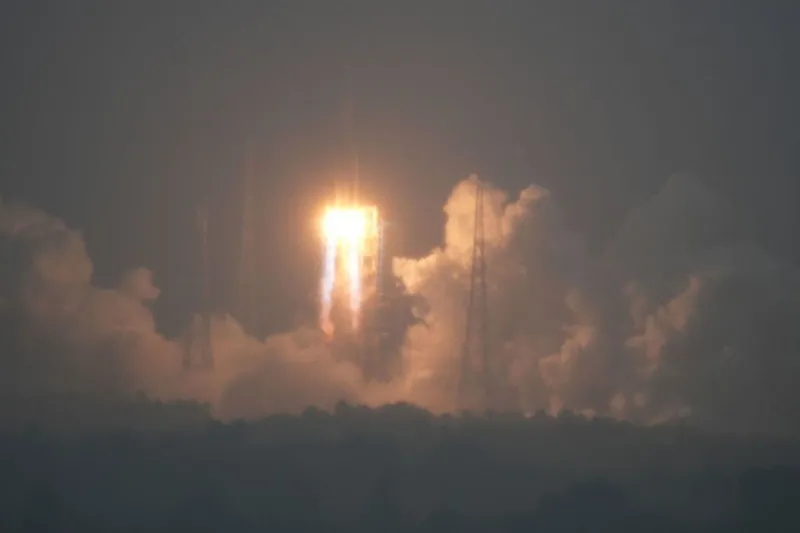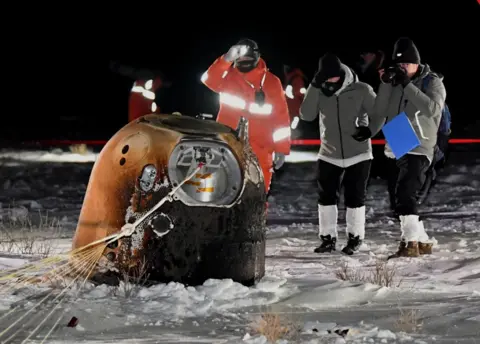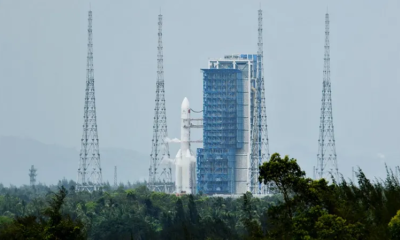Foreign News
China says its spacecraft lands on Moon’s far side

China says its uncrewed craft has successfully landed on the far side of the Moon – an unexplored place almost no-one tries to go.
The Chang’e 6 touched down in the South Pole-Aitken Basin at 06:23 Beijing time on Sunday morning (22:23 GMT Saturday), the China National Space Administration (CNSA) said.
Launched on 3 May, the mission aims to collect precious rock and soil from this region for the first time in history. The probe could extract some of the Moon’s oldest rocks from a huge crater on its South Pole.
The landing was fraught with risks, because it is very difficult to communicate with spacecraft once they reach the far side of the Moon. China is the only country to have achieved the feat before, landing its Chang’e-4 in 2019.
After launching from Wenchang Space Launch Center, the Chang’e 6 spacecraft had been orbiting the Moon waiting to land. The lander component of the mission then separated from the orbiter to touch down on the side of the Moon that faces permanently away from Earth.
During the descent, an autonomous visual obstacle avoidance system was used to automatically detect obstacles, with a visible light camera selecting a comparatively safe landing area based on the brightness and darkness of the lunar surface, the CNSA was quoted as saying by state-run Xinhua news agency.
The lander hovered about 100m (328ft) above the safe landing area, and used a laser 3D scanner before a slow vertical descent. The operation was supported by the Queqiao-2 relay satellite, the CNSA said.
Chinese state media described the successful landing as an “historic moment”. The state broadcaster said “applause erupted at the Beijing Aerospace Flight Control Center” when the Chang’e landing craft touched down on the Moon early on Sunday morning.
The lander should spend up to three days gathering materials from the surface in an operation the CNSA said would involve “many engineering innovations, high risks and great difficulty”. “Everyone is very excited that we might get a look at these rocks no-one has ever seen before,” explains Professor John Pernet-Fisher, who specialises in lunar geology at the University of Manchester.
He has analysed other lunar rock brought back on the American Apollo mission and previous Chinese missions. But he says the chance to analyse rock from a completely different area of the Moon could answer fundamental questions about how planets form.
Most of the rocks collected so far are volcanic, similar to what we might find in Iceland or Hawaii. But the material on the far side would have a different chemistry . “It would help us answer those really big questions, like how are planets formed, why do crusts form, what is the origin of water in the solar system?” the professor says.
The mission aims to collect about 2kg (4.4lb) of material using a drill and mechanical arm, according to the CNSA.
The South Pole–Aitken basin, an impact crater, is one of the largest known in the solar system.
From there, the probe could gather material that came from deep inside the lunar mantle – the inner core of the Moon – Prof Pernet-Fisher says.
The Moon’s South Pole is the next frontier in lunar missions – countries are keen to understand the region because there is a good chance it has ice.

The capsule in the last Chinese moon mission, Chang’e 5, brought back soil and rocks in 2020 (BBC)
Access to water would significantly boost the chances of successfully establishing a human base on the Moon for scientific research.
If the mission succeeds, the craft will return to Earth with the precious samples on board a special return capsule.
The material will be kept in special conditions to try to keep it as pristine as possible.
Scientists in China will be given the first chance to analyse the rocks, and later researchers around the world will be able to apply for the opportunity too.
This is the second time China has launched a mission to collect samples from the Moon.
In 2020 Chang’e 5 brought back 1.7kg of material from an area called Oceanus Procellarum on the Moon’s near side.
China is planning three more uncrewed missions this decade as it looks for water on the Moon and investigates setting up a permanent base there.
Beijing’s broader strategy aims to see a Chinese astronaut walk on the moon by around 2030.
The US also aims to put astronauts back on the moon, with Nasa aiming to launch its Artemis 3 mission in 2026.
(BBC)
Foreign News
Six police officers killed in Thailand plane crash

Six police officers have been killed in Thailand after their plane crashed into the sea during a test flight for parachute training, police have said.
The small plane was seen crashing into the water at around 08:00 local time (01:00 GMT) on Friday in the Cha-am district, a coastal resort area some 130km (80 miles) southwest of Bangkok.
Royal Thai Police said in a statement on Facebook that five of the officers died at the scene, with a sixth later dying in hospital.
Authorities are examining the aircraft’s black box data recorder to determine the cause of the crash.
(BBC)
Foreign News
More than 20 killed after gunmen open fire on tourists in Indian-administered Kashmir

At least two dozen people have been killed after gunmen opened fire on a group of domestic tourists visiting a popular beauty spot in Indian-administered Kashmir, authorities have told the BBC.
The attack took place in Pahalgam, a picturesque town in the Himalayas often described as the “Switzerland of India”.
The region’s chief minister, Omar Abdullah, said the attack was “much larger than anything we’ve seen directed at civilians in recent years”. Reports suggest that there are a large number of wounded, with some in critical condition.
US President Donald Trump, Russian President Vladimir Putin and EU chief Ursula Von der Leyen were among world leaders who condemned the attacks.
“Deeply disturbing news out of Kashmir. The United States stands strong with India against Terrorism,” Trump said in a post on Truth Social.
Von der Leyen called the Kashmir deaths a “vile terrorist attack”, while Putin expressed “sincere condolences” for the consequences of a “brutal crime”.
India’s Prime Minister Narendra Modi – who cut short his trip to Saudi Arabia in the wake of the attack – said the perpetrators would “be brought to justice”.
“Our resolve to fight terrorism is unshakeable and it will get even stronger,” Modi wrote in a statement on X.
Tuesday’s attack is unusual in that, in three and a half decades of conflict, tourists have rarely been targeted – especially on such a scale.
Home Minister Amit Shah travelled to Srinagar, Kashmir’s largest city, on Tuesday to hold an emergency security meeting.
The region’s Lieutenant Governor, Manoj Sinha, said the army and police had been deployed to the scene.
No group has claimed responsibility for the attack. There has been a long-running insurgency in the Muslim-majority region since 1989, although violence has waned in recent years.
The attack took place in Baisaran, a mountain-top meadow three miles (5km) from Pahalgam.
Vehicles are unable to reach the area where the shooting occurred, Inspector General of Jammu and Kashmir Police Vidi Kumar Birdi told BBC Hindi.
A tourist from Gujarat, who was part of a group that was fired upon, said that chaos broke out after the sudden attack, and everybody started running, crying and shouting.
Video footage shared by Indian media outlets appears to show Indian troops running towards the scene of the attack, while in other footage victims can be heard saying that the gunmen had singled out non-Muslims.
Footage on social media, which has not been verified by the BBC, appears to show bodies lying on a meadow with people crying and pleading for help.
Police said multiple tourists had been taken to hospital with gunshot wounds. The area has been cordoned off and soldiers are stopping vehicles at checkpoints. A joint search operation by the Indian army and Jammu and Kashmir police is ongoing.
Several protests have been organised for Wednesday, according to Indian media.
Since the 1990s, an armed separatist insurgency against Indian rule in the region has claimed tens of thousands of lives, including those of civilians and security forces.
The Himalayan region was divided following India’s independence from Britain, partition and the creation of Pakistan in 1947.
The two uclear armed states both claim the region in its entirety and have fought two wars and a limited conflict over it in the decades since.
Some 500,000 Indian soldiers are permanently deployed in the territory. The government claims the security situation has improved and violence has come down since Modi revoked Kashmir’s partial autonomy in 2019, although there are still incidents of violence.
The last major attack on civilians occurred in June 2024 when nine people were killed and 33 injured after militants opened fire on a bus carrying Hindu pilgrims. In 2019, a suicide bombing in Indian administered Kashmir killed at least 46 soldiers and prompted Indian airstrikes on targets in Pakistan.
Pahalgam is a popular tourist destination, both domestically and internationally, and in recent years the government has attempted to encourage further tourism to the region.
Around 3.5 million tourists visited Kashmir in 2024, according to official figures.
[BBC]
Foreign News
Gunmen shoot 12 dead at Ecuador cockfight

Police in Ecuador say they have arrested four people in connection with an attack by gunmen at a cockfighting ring in which 12 people died.
Weapons and replica police and army uniforms were seized during police raids in the north-western Manabí province on Friday – a day after the attack in the rural community of La Valencia.
Footage of the attack shared on social media showed gunmen entering the ring and opening fire, as terrified spectators dived for cover.
Reports in local media suggested the attackers in fake military gear were members of a criminal gang whose rivals were at the cockfight.
A criminal investigation has been launched by the provincial authorities.
As many as 20 criminal gangs are believed to be operating in the Latin American country, vying for control over major drug routes.
Ecuadorean President Daniel Noboa has said that about 70% of the world’s cocaine now flows through Ecuador’s ports before being shipped to the US and Europe.
The drug is smuggled into Ecuador from neighbouring Colombia and Peru – the world’s two largest producers of cocaine.
This January saw 781 murders, making it the deadliest month in recent years. Many of them were related to the illegal drug trade.
[BBC]
-

 News6 days ago
News6 days agoFamily discovers rare species thought to be extinct for over a century in home garden
-

 Features4 days ago
Features4 days agoRuGoesWild: Taking science into the wild — and into the hearts of Sri Lankans
-

 News4 days ago
News4 days agoOrders under the provisions of the Prevention of Corruptions Act No. 9 of 2023 for concurrence of parliament
-

 Features5 days ago
Features5 days agoNew species of Bronzeback snake, discovered in Sri Lanka
-

 News3 days ago
News3 days agoProf. Rambukwella passes away
-

 Features6 days ago
Features6 days agoThe ironies of history
-

 News5 days ago
News5 days agoPhoto of Sacred tooth relic: CID launches probe
-

 Opinion4 days ago
Opinion4 days agoSri Lanka’s Foreign Policy amid Geopolitical Transformations: 1990-2024 – Part IX
















